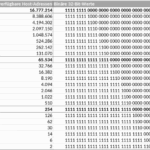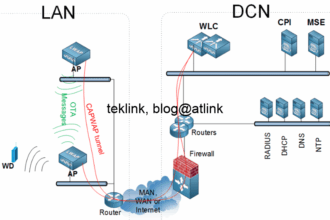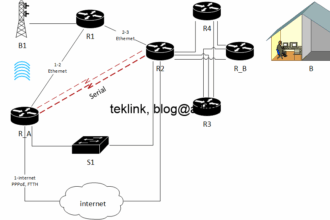In this blog, let’s discover how ethernet cabling helps improve the speed over copper.
Introduction
In this post let’s talk about cabling, especially ethernet cabling to meet speeds of 1 gig. 4 elements are discussed : operation as described in the standard, awg metric, pinout and twist. Alternatives to this copper cabling are: wireless, fiber, etc. to achieve the same speed and transmit capacity.
Theoretical background
Ethernet cabling
1 gig per second operation is described in the ieee802.3ab standard under the designation of 1000base-T over a classe D cat.5 cable of 100 meters lenght maximum and a supported signal frequency of more than 100MHz.
AWG metric
The awg metric measures the quality of the cable. The greater the awg is, the lesser is the attenuation to the electrical signal and better the signal quality… An awg of 26 is better than an 24 awg cable.
1 gig cable pinout (RJ45)
The 1 gig standard allows data transmission over the 4 pairs that compose the Ethernet cable. 2 bits per baud are sent over each pair, using a 5-moment code, simltaneously and in a full duplex operation. The pinout is described in the following figure: 2 standards are defined T568A and B. Only green (+white green) and orange (+white orange) are used for transmit and receipt. The blue and brown are for noise and interference cancellation.

We can easily check that the 1gig speed is not achieved is we do not respect those standards. For a crossover operation (like connecting 2 routers or a router to host PC or server) one plug (RJ45) is done using the A standard and the other using B. In straightforward operation (like connecting a host to a switch or 2 switches using mdx (the technology that detects automatically the type of the cable)), both plug are using the same standard A or B.
Cable twist (and protection)
In addition to the cable characteristics, the how is an RJ45 cable plug is crafted is very important…
First test: no twist

For test purposes, let’s craft our RJ45 plug using this wiring (which is not standard)
The arrows designate the electrical polarization of each pair’s signal. Let’s imagine 2 electromagnetic waves with different amplitudes. We suppose that the cross-wire intersection of the waves corresponds to the resultant electromagnetic interference at any point on any wire. Then we see more interference when the amplitude of the wave is important.
If we concentrate on the solid blue curve, a point may suffer from solid marron line interference when is signal is positive… The same happens for the other lines.
Second test: no twist but give it more space
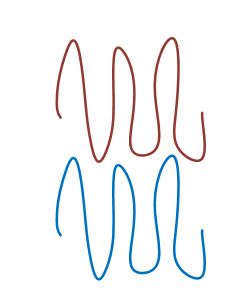
What if we separate the solid blue curve from the marron one in this way, shown in the following figure, no interference could occur in between the blue and marron lines…
Now our signal is distinct. But we still need to fit in the 2 other signals. The best fit is to guarantee that at each time the signals are distinguishable either by amplitude or by phase. Also to guarantee the smallest plug form dimension…
Third test: twist to get more space
What are our possibilities for the 3rd curve?
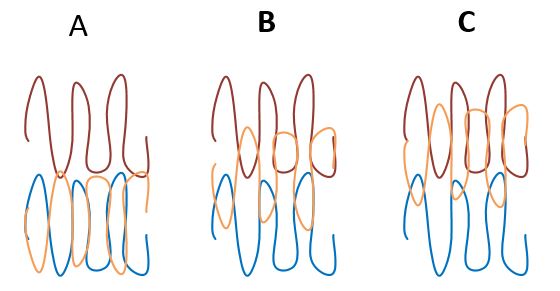
In A, if we send blue and orange simultaneously the signal may get cancelled. We could imagine a time synchrnization but it would be very costy to integrate and maintain a synchronized clock… (we’re no more doing packet switched networking!)
In B, the effect of the orange wave is applied to both blue and marron curves but in a lessened proportion. At any point and time either the signals are of opposite phase or the amplitude is sufficiently different…
In C, the effect of the orange wave is more on the marron curve that the blue one. This supposes a bigger plug to fit them also…
Fourth test: twist and cancel interference
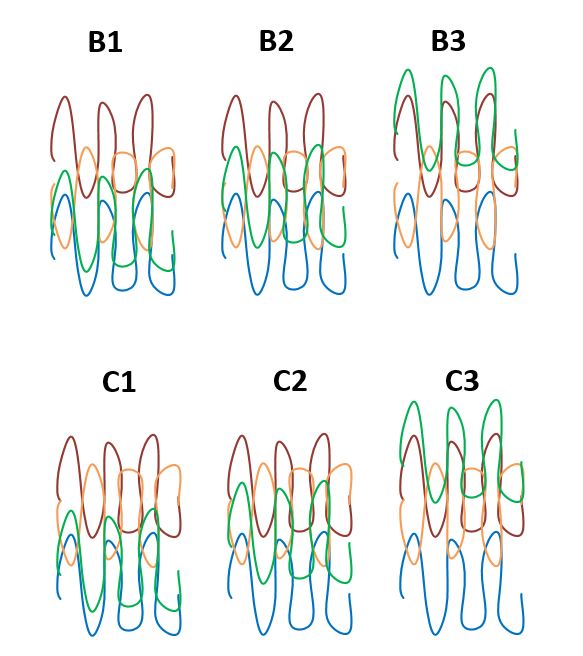
We retain both B and C configurations and let’s try to fit the last curve (the green). Our possibilities are:
In B1, B2, C1 and C2, the green wave suffers of interference from both the blue and marron curves…

B3 offers a better orange signal decoding if we imagine this simplification
Craft a cable as a professional
Crafting a cable is 2 task operation: 1) the cable itself, lines twist, protection, etc. and 2) the plug (RJ45).
Basically all what we need is copper: 2 strands (green and orange). one strand for transmit and the other for receive. to optimize the transmit and receive operation we add 2 more strands (white-green and white-orange) for noise cancellation to allow the receiver (let’s recal that the idea of any communication is to connect the receiver on one side to the transmitter on the other side) in each side to well interpret the signal (if sufficent information to decode bit 0 or 1 levels) of utility by substracting the noise present in those white-color strands.
The way the other four strands are put are very usefull for interference and noise cancellantion: the blue is alway in between the green and orange whereas the brown is at side depending on the standards it’s nearset to the orange or green strand… also “mechnically” protect the usefull strands.
As conclusion
Ethernet copper cabling is very complicate (to achieve a high speed full duplex communication) and aims at canceling interference. For this purpose the way pairs are pinout and twisted is very important to cancel interference and noise in at least 2 ways: prevent addition or cancelation of signals, capture noise and deleted at receivers, etc.


